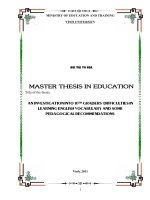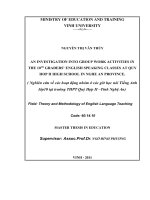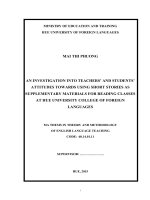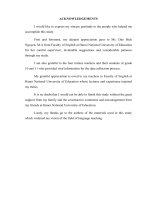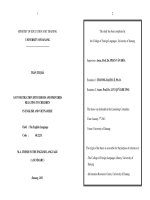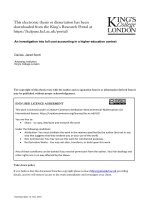An investigation into domestication and foreignization in the english translation of culture spec
Bạn đang xem bản rút gọn của tài liệu. Xem và tải ngay bản đầy đủ của tài liệu tại đây (2.35 MB, 95 trang )
THE UNIVERSITY OF DANANG
UNIVERSITY OF FOREIGN LANGUAGE STUDIES
ĐOÀN THỊ NGỌC BÍCH
AN INVESTIGATION INTO DOMESTICATION
AND FOREIGNIZATION IN THE ENGLISH
TRANSLATION OF CULTURE-SPECIFIC
ITEMS IN VŨ TRỌNG PHỤNG’S DUMB LUCK
NOVEL AND READERS’ PERCEPTION
MASTER THESIS IN
LINGUISTICS AND CULTURAL STUDIES
OF FOREIGN COUNTRIES
Da Nang, 2020
THE UNIVERSITY OF DANANG
UNIVERSITY OF FOREIGN LANGUAGE STUDIES
ĐOÀN THỊ NGỌC BÍCH
AN INVESTIGATION INTO DOMESTICATION
AND FOREIGNIZATION IN THE ENGLISH
TRANSLATION OF CULTURE-SPECIFIC ITEMS
IN VŨ TRỌNG PHỤNG’S DUMB LUCK NOVEL
AND READERS’ PERCEPTION
Major: ENGLISH LINGUISTICS
Code: 822 02 01
MASTER THESIS IN
LINGUISTICS AND CULTURAL STUDIES
OF FOREIGN COUNTRIES
SUPERVISOR: NGUYỄN THỊ THU HƯỚNG, Ph.D
Da Nang, 2020
i
STATEMENT OF AUTHORSHIP
Except where reference is made in the text of the thesis, this thesis contains no
material published elsewhere or extracted in whole or in part from a thesis by which
I have qualified for or been awarded another degree or diploma.
No other person‘s work has been used without due acknowledgements in the
thesis.
This thesis has not been submitted for the award of any degree or diploma in
any other tertiary institution.
Da Nang, May 2020
Doan Thi Ngoc Bich
ii
ACKNOWLEDGEMENTS
During the process of fulfilling the graduation paper, I have received much
encouragement and essential assistance from my teachers, family, and domestic as
well as foreign friends. Sincerely from the bottom of my heart, I highly appreciate
their cooperation and support.
I would like to send my deep gratitude to Ms. Nguyen Thi Thu Huong, the
supervisor of this graduation paper. Her useful recommendation, detailed comments
and practical encouragement have helped me obtain the aim and shape my ideas.
Therefore, it is the fact that the paper would not have been completed without her
enthusiasm.
I warmly thank all my family, friends and colleague for their valuable help
throughout the process of writing the thesis. Especially, I give thanks to my
international friends for their effective and precious cooperation during the process
to complete the survey of the questionnaire.
iii
ABSTRACT
Recognizing the importance of culture-specific items (CSIs) in translation,
the researcher aims to analyze whether Vietnamese culture-specific items have been
translated into English based ondomestication or foreignization. Data were based on
culture-specific items taken from ―Số Đỏ‖ novel of Vũ Trọng Phụng and their
English equivalents in the Vietnamese version by Nguyễn Nguyệt Cầm and Peter
Zinoman. This research also examines readers‘ perception of the cultural words. It
investigates if readers have difficulties as well as misunderstanding in
comprehending culture-specific items in the English translation of ―Dumb Luck‖
novel. To conduct the survey, the questionnaire was designed with 10 domesticated
cuture-specific items and 10 foreignized culture-specific items taken from ―Dumb
Luck‖ novel to obtain feedbacks from three foreign readers. The findings indicate
that the background information plays a significant role in improving the
comprehensibility of foreign readers about Vietnamese culture-specific items. The
occurrences of foreignizing were much higher than domestication with the
domination of literal translation technique. However, the translators should have a
parallel combination of both ―domestication‖ and ―foreignization‖ when
translating culture-specific items into English. It is essential to provide the
background information in order to enhance the effectiveness of English translated
Vietnamese masterpieces. At the same time, it is necessary to consider the level of
the comprehensiveness to create closeness for foreign readers. Besides, translators
should conduct a survey about readers‘ perception designed for various foreign
audiences so that translated texts are more popular with international friends.
Key words: culture-specific items (CSIs), domestication, foreignization,
readers‘ perception
iv
TABLE OF CONTENTS
STATEMENT OF AUTHORSHIP ......................................................................... i
ACKNOWLEDGEMENTS ..................................................................................... ii
ABSTRACT ............................................................................................................. iii
TABLE OF CONTENTS ........................................................................................ iv
LIST OF TABLES ................................................................................................. vii
LIST OF CHARTS.................................................................................................. ix
LIST OF APPENDICES .......................................................................................... x
Chapter One INTRODUCTION ............................................................................ 1
1.1. RATIONALE ............................................................................................. 1
1.2. AIMS AND OBJECTIVES ........................................................................ 2
1.3. RESEARCH QUESTIONS ........................................................................ 3
1.4. SCOPE OF THE STUDY .......................................................................... 3
1.5. SIGNIFICANCE OF THE STUDY ........................................................... 7
1.6. ORGANIZATION OF THE STUDY ........................................................ 7
Chapter Two THEORETICAL BACKGROUND AND LITERATURE
REVIEW ................................................................................................................... 9
2.1. LITERATURE REVIEW .................................................................................... 9
2.2. THEORETICAL BACKGROUND ...................................................................11
2.2.1. Translation and Culture ..........................................................................11
2.2.2. Domestication and Foreignization ..........................................................13
2.2.3. Translation Procedures ...........................................................................14
2.2.3.1. Borrowing ........................................................................................15
2.2.3.2. Definition .........................................................................................15
2.2.3.3. Literal translation ............................................................................16
2.2.3.4. Substitution ......................................................................................16
2.2.3.5. Lexical creation ...............................................................................17
2.2.3.6. Omission ..........................................................................................17
v
2.2.3.7. Addition ............................................................................................17
2.2.4. Readers‘ Perception ................................................................................18
2.3. SUMMARY .......................................................................................................19
Chapter Three METHODOLOGY .......................................................................21
3.1. RESEARCH DESIGN .......................................................................................21
3.2. RESEARCH METHODS ...................................................................................21
3.3. PROCEDURES ..................................................................................................22
3.3.1. Data Collection .......................................................................................22
3.3.2. Data Analysis ..........................................................................................24
3.4. RELIABILITY AND VALIDITY .....................................................................25
3.5. SUMMARY .......................................................................................................25
Chapter Four FINDINGS AND DISCUSSIONS .................................................26
4.1. DOMESTICATION AND FOREIGNIZATION IN CSIs .................................26
4.1.1. Character names ......................................................................................26
4.1.2. Place names .............................................................................................30
4.1.3. Social classes ..........................................................................................32
4.1.4. Fashion ....................................................................................................34
4.1.5. Measuring system ...................................................................................36
4.1.6. Food and drink ........................................................................................38
4.1.7. Addressing system ..................................................................................42
4.1.8. Entertainment forms ...............................................................................45
4.1.9. Expressions .............................................................................................46
4.1.10. Summary ...............................................................................................52
4.2. READERS‘ PERCEPTIONS .............................................................................52
4.2.1. Readers‘ perception ................................................................................52
4.2.2. Summary .................................................................................................56
Chapter Five CONCLUSIONS AND IMPLICATIONS .....................................58
5.1. CONCLUSIONS ................................................................................................58
5.2. IMPLICATIONS ................................................................................................58
vi
5.2.1. To Translators .........................................................................................58
5.2.2. To Students and Teachers .......................................................................59
5.2.3. To Linguists ............................................................................................59
5.2.4. To Sociologist .........................................................................................59
5.3. LIMITATIONS OF THE STUDY .....................................................................59
5.4. SUGGESTIONS FOR FURTHER RESEARCHES ..........................................60
REFERENCE ..........................................................................................................61
APPENDIX 1 ...........................................................................................................63
APPENDIX 2 ...........................................................................................................79
QUYẾT ĐỊNH GIAO ĐỀ TÀI LUẬN VĂN (bản sao)
vii
LIST OF TABLES
Number
Table 2.1.
Name of Tables
Page
Procedures that can be applied in Foreignization and
Domestication strategies
18
Table 3.1.
The Division of the CSIs and translation procedure
23
Table 4.1.
The Translational Strategies Of Character Names
26
Table 4.2.
The Translational Strategies Of Place Names
30
Table 4.3.
The Translational Strategies of Social Classes
32
Table 4.4.
Table 4.5.
Table 4.6.
Table 4.7.
Table 4.8.
Table 4.9.
Table 4.10.
Table 4.11.
Table 4.12.
Table 4.13.
Table 4.14.
Table 4.15.
Examples of Definition Applied in Translating CSIs of Social
Classes
The Translational Strategies of Fashion
34
Examples of Substitution Applied in Translating CSIs of
Fashion
Examples of Definition Applied in Translating CSIs of
Fashion
The Translational Strategies of Measuring System
Examples of
Substitution and Borrowing
35
36
36
Applied
in
Translating CSIs of Measuring System
The Translational Strategies of Food and Drink
Examples of Substitution Applied in Translating CSIs of Food
and Drink
Examples of Literal Applied in Translating CSIs of Food and
Drink
Examples of Literal Translation Applied in Translating CSIs
of Food and Drink
The Translational Strategies of Addressing System
Examples of Definition Applied in Translating Addressing
system
33
37
38
39
40
41
42
42
viii
Number
Table 4.16.
Name of Tables
Examples of Literal Translation Applied in Translating
Addressing system
Page
44
Table 4.17.
The Translational Strategies of Entertainment Forms
45
Table 4.18.
The Translational Strategies of Expressions
46
Table 4.19.
Examples of Substitution Applied in Translating Expressions
47
Table 4.20.
Examples of
Literal Translation Applied in Translating
Expressions
47
Table 4.21.
Examples of Omission Applied in Translating Expressions
50
Table 4.22.
The Translational Strategies of CSIs
51
Table 4.22.
Examples misunderstood by Reader 1
55
Table 4.23.
Examples misinterpreted by reader 3
56
ix
LIST OF CHARTS
Name of Chart
Page
Number
Chart 4.1.
Domestication and Foreignization of Place Names
26
Chart 4.2.
Domestication and Foreignization of Place Names
31
Chart 4.3.
Domestication and Foreignization of Social Classes
32
Chart 4.4.
Domestication and Foreignization of Fashion
34
Chart 4.5.
Domestication and Foreignization of Measuring System
36
Chart 4.6.
Domestication and Foreignization of Food and Drink
38
Chart 4.7.
Domestication and Foreignization of Addressing System
44
Chart 4.8.
Domestication and Foreignization of Entertainment Forms
45
Chart 4.9.
Domestication and Foreignization of Expressions
46
Chart 4.10. Domestication and Foreignization of CSIs
51
Chart 4.11. Readers’ Perception About Foreignization and Domestication
52
Chart 4.12. Domestication and Foreignization of Readers’ perception
53
x
LIST OF APPENDICES
Name’s Appendix
Number
Page
Appendix A
CSIs
61
Appendix B
Questionaire
79
1
Chapter One
INTRODUCTION
1.1. RATIONALE
Each nation has its own geography, lifestyle, history, traditions, customs
which form distinguishing cultures in different territories. Vietnam is located in the
region of tropical climate with complex geography and it represents long-term wetrice agriculture and, the struggle against foreign invasion. Those cultural features
are vividly reflected in the language. Translators play a significant role in conveying
messages from the source language to the target language. It is not easy to avoid
cultural and geographic barriers in translation. One of the problems of translation is
to transfer culture-specific items which feature the historical, social, and cultural
development of the country.
Domestication and foreignization are common translation strategies which
deal with cultural and linguistic elements. Domestication, which gives priority to
fluent and understandable style, is adapted to target the comprehensibility of
domestic readers and minimize the strangeness of the foreign text whereas
foreignization keeps the target text foreign and original. Bhabha (1994) points out
that translation especially in literature plays a vital part in cultural communication.
According to him, language is considered as a kind of cross-cultural
communication, which frequently has to face up to „foreignness‘, in the sense that
the existence of cultural elements are probably untranslatable. In agreement with
Bhabha, Venuti also confirms that translation involves cultural communication;
however, the culture has been transferred from the original language to the target
language that has certain differences in meaning of cultural words. This is what has
been understood as domestication, which means that foreign factors in the original
text has been translated or rewritten into elements that are expressed to aim to be
familiar to the readers, as Venuti says: ―…foreign text is rewritten in domestic
dialects and discourses, registers and styles, which results in the production of
2
textual effects that signify only in the history of the domestic language and culture‖
(Venuti, 2000, p. 471).
It can be seen that domestication and foreignization are two translation
strategies to deal with linguistic and cultural issues. However, the studies about
domestication and foreignization in Vietnamese-English translation have been still
limited, particularly in literature. Besides, studies about readers‘ perception are not
found much. With an effort to find out how Vietnamese cultural items are translated
into foreign languages, especially English and analyze domestication and
foreignization as well as readers‘ perceptions of translation, I choose “An
investigation into domestication and foreignization in the English translation of Vũ
Trọng Phụng‟s Dumb Luck novel and foreign readers‟ perception” as my topic.
1.2. AIMS AND OBJECTIVES
1.2.1. Aims
This study primarily aims to analyse Vietnamese-English translation of
culture-specific items in the novel ―So Do‖ by vu Trong Phung. The study also
presents foreign readers‘ perception of translated culture-specific items in order to
provide effective solutions to expand literal masterpieces translated into English to
international readers. The study hopefully provides foreign readers with an insight
into Vietnamese culture so that they are able to better interact in communication in
Vietnam.
1.2.2. Objectives
To achieve the aim of the study, the following objectives have to be
accomplished:
1. To identify culture-specific items in Vũ Trọng Phụng‘s Dumb Luck novel
2. To find out the use of foreignization or domestication in dealing with
translated culture-specific items
3. To present foreign readers‘ perception of translated cultural items
3
1.3. RESEARCH QUESTIONS
To achieve the aims and objectives mentioned above, the study seeks the
information for the following research questions:
1. Which translation strategy - domestication or foreignization is used more
often in translating CSIs in English?
2. What are English readers‘ perceptions about CSIs in Dumb Luck novel?
1.4. SCOPE OF THE STUDY
The study primarily will examine the translation strategies of domestication
or foreignization toward culture-specific items including character names, place
names, social classes, fashion, measuring system, food and drink, addressing
system, entertainment forms and expressions in Vu Trong Phung‘s Dumb Luck
novel, which was published first in serial form in the Hanoi Newpaper (Hà Nội
Báo) starting on 7 October 1936. The novel is translated from Vietnamese into
English by Nguyễn Nguyệt Cầm and Peter Zinoman, with an introduction by Peter
Zinoman, published by the University of Michigan Press.
Vũ Trọng Phụng (1912-1939) is a writer, a journalist of the twentieth century
with a number of typical masterpieces. Even though he passed away at the age of
his twenty-seventh birthday, he composed a body of work consisting of seven plays,
eight novels, and five works of nonfiction. Dumb Luck is generally regarded as his
most successful masterpiece.
Dumb Luck, by the talented and controversial Vietnamese writer Vũ Trọng
Phụng was launched in Hanoi in 1936 and translated from Vietnamese into English
by Nguyễn Nguyệt Cầm and Peter Zinoman. The masterpiece criticizes the colonial
society of Vietnam which many Vietnamese greeted the Popular Front victory.
According to Peter Zinoman (2003), references to ―progress‖ (tiến bộ), science
(khoa học), social reform (cải cách xã hội), ―womens rights‖ (nữ quyền), ―the
sporting movement‖ (phong trào thể thao), civilization‖ (văn minh), ―modernity‖
4
(tân thời) recall the progressive language dominating the public during the era.
The investigation into different readers‘ comprehension around the world is
considered as a new trend nowadays. Therefore, this study also investigates three
foreign readers‘ perception about Vu Trong Phung‘s Dumb Luck novel. Reader 1 is
also an English teacher from South Africa and has spent 2 years in Quang Ngai.
Reader 2, an English teacher is Australian and has lived in Central Vietnam for 5
years but has travelled all over from Northern to Southern Vietnam. Reader 3, an
English teacher, comes from Colombia and has lived in Sai Gon and Quang Ngai for
a year.
―Số Đỏ‖ of Vũ Trọng Phụng published in 2018 and ―Dumb Luck‖ (2003)
translated from Vietnamese into English by Nguyễn Nguyệt Cầm and Peter
Zinoman are chosen to conduct the research. The English version of ―Dumb Luck‖
(2003) was named by the Los Angeles Times as the best book of 2003; therefore, it
is quite popular in the international book market.
5
6
7
1.5. SIGNIFICANCE OF THE STUDY
This study aims to explore how cultural items are translated from Vietnamese
into English, and explain the misunderstanding in communication between
Vietnamese and foreigners because of culture barriers. The results of the study can
provide useful insight for the translators, English learners, educators about the
tendency of domestication and foreignization, especially in translating literature.
The study hopefully provides foreign readers with an understanding of Vietnamese
culture.
1.6. ORGANIZATION OF THE STUDY
The study is presented in the following parts:
Chapter 1: Introduction
The introduction chapter introduces background and rationale of this study,
and summarizes research questions and outline of this paper.
Chapter 2: Literature Review and Theoretical Background
Chapter 2 is theoretical background which clarifies some important concepts
in the study. In this chapter, some of the previous research on weather forecasts
were presented.
Chapter 3: Research Methods
Methodology of this study is introduced in chapter 3, which describes data
collection and data analysis in detail.
Chapter 4: Findings and Discussions
Chapter 4 focuses on the results and discussion. In this chapter, answers to
research questions raised in the Introduction section are provided though
quantitative analysis.
8
Chapter 5: Conclusions and Implications
Conclusions are drawn to general findings of this study, limitations of this
study stated and suggestions put forward for the future research.
9
Chapter Two
THEORETICAL BACKGROUND AND LITERATURE REVIEW
In this chapter I review some of the previous research on domestication and
foreignization, in order to gain an overall view of the state of affairs in this research
area, and to pinpoint what further research needs to be conducted. This chapter is
arranged as follows: 2.1 Literature Review. 2.2 Theoretical Background. 2.3
Summary.
2.1. LITERATURE REVIEW
Many researchers have presented evidence about the dominant translational
strategies. They demonstrate that foreignization seems to become more and more
popular in translation. Ebrahim Davoudi, Sharifabad, Mojde Yaqubi, and Tengku
Sepora Tengku Mahadi (2013) point out that domestication dominates
foreignization with the rate of seven and three. Both domestication and
foreignization translation strategies involve losses which are unavoidable in
translating (p. 98).
Firstly, according to Esmail Zare-Behtash and Sepideh Firoozkoohi (2009, p.
1582), domestication is regarded as the principal method applied in the Persian
translations of six books of Hemingway. These language theorists also claim that
―domestication has been the most pervasive cultural translation strategy from the
1950s to the 2000s‖ (p. 1582). However, there is no doubt that there is the shift from
domestication to foreignization or vice versa ―over the last six decades‖.
MSc. Eriola Qafzezi (2013) investigates into children‘s literature translated
into Albanian to show the level of visibility of the original author and culture versus
the translator in the original language and domesticating vs. foreignizing tendencies.
The author used the translational strategies by Vladimir Ivir, including substitution,
omission, lexical creation (domestication) and borrowing, literal translation,
definition, and addition (foreignization). The researcher investigates into
10
foreignization and domestication tendencies in Gulliver‘s Travels and four Albanian
variants of ―Alice‘s Adventures in Wonderland‖ and revealed that there was little
variation in all variants with almost the same rate. ―Dominating tendency in
translation of CSIs in Gulliver‘s Travels is evidently foreignization‖ (MSc. Eriola
Qafzezi, 2013, p. 572). Generally, ―both Outlaws of the Marsh translated by
Sidney Shapiro and All Men Are Brothers translated by Pearl S. Buck use these two
kinds of methods although the former domestication-oriented while the latter is
foreignization-oriented‖ (Ling Yan, 2013, p. 35).
More recently, Awadh. G. Baawaidhan (2016) described translational
solutions of CSIs. The study showed that foreignization was applied frequently in
translating the titles of episodes and popular proverbs, while the translator has used
domestication in other categories including religious expressions and cultural
expressions.
As for readers‘ perception, Libin Wang (2012, p. 46-47) confirms that
Australian university students find it difficult to comprehend the English translation
of the eight Chinese slogans. In spite of learning Chinese, and some in high-level
classes, participants feel fairly difficult to comprehend Chinese political slogans.
―Some participants merely commented on the slogans instead of interpreting
them‖. However, due to their limited background of Chinese culture, a number of
the participants were likely to obtain partial understanding of a number of slogans
despite culture-specific items.
Chesnokova, Zyngier, Viana, Jandre, Rumbesht andRibeiro (2017),
examined reactions to ―a canonical romantic poem in four languages—English,
Portuguese, Russian, and Ukrainian—by readers from two different cultural
settings—Brazil and Ukraine‖ (p. 842). The researchers conclude that there is a
similarity in ―relation to how Brazilian and Ukrainian readers respond to Poe‘s
poetry‖ (p. 844). Both readers‘ own culture and the language in which they read a
poem may have an effect on their responses. The authors also suggested the area of
11
cross-cultural reader response to original and translated poetry should be explored
further. Despite the trendy research in readers‘ reactions to translations, there is such
limited investigation in Vietnamese-English translation. This study aims to provide a
brief look into English readers‘ response to the English translation Dumb Luck.
2.2. THEORETICAL BACKGROUND
2.2.1. Translation and Culture
Translation has a close relationship with culture as stated by various
translation theorists. It is true that researchers find it hard to isolate the meaning of
cultural items from their cultural background. According to Bassnett and Trivedi,
translation occurs in ―a continuum‖, not in ―a vacuum‖; it is not a separate process
but a series of related things. It is true that it is part of a continuous process of
―intercultural transfer‖. Besides translation covers a significantly dominant activity
that includes all types of ―stages that process of transfer across linguistic and
cultural boundary.‖ (Bassnett & Trivedi, 1999, p. 2)
The definition of culture is quite necessary and vital in investigating the
implications for translation since it informs us of customs, lifestyle, intellectual and
humane values of a particular people or society. A large number of scholars define
culture in various ways. Larson (1984) states culture as ―a complex of beliefs,
attitudes, values, and rules which a group of people share‖ (Larson, 1984, p. 430).
Schmitt (1999) claims that culture is considered as ―everything that a person
should know, be able to feel and to do, in order to succeed in behaving and acting in
an environment like somebody from this environment‖ (Schmitt, as cited in
Gambier, Shlesinger, & Stolze, 2007, p. 33). Newmark (1988) regards culture as
―the way of life and its manifestations that are peculiar to a community that uses a
particular language as its means of expression‖ (p. 94).
Aixelá (1996) defines the culture-specific item as: (indented)
―those textually actualized items whose function and connotations in a source text
12
involve a translation problem in their transference to a target text, whenever this
problem is a product of the nonexistence of the referred item or of its different
intertextual status in the cultural system of the reader of the target text‖ (p. 58).
According to Li and Xia (2010), the process of translation consists of two
languages which carry distinct cultural features; therefore, this translation is both
the procedure of transfer between languages and ―a communication between
diverse cultures‖. Leppihalme (1997) investigates into cultural studies, and points
out that the target language does not totally assemble with the origin of linguistic
material. She proposes that:
―The texts occur in a given situation in a given culture in the world, and each has a
specific function and an audience of its own. Instead of studying specimens of language
under laboratory conditions as it were, the modern translation scholar-and the translatorthus approaches a text as if from a helicopter: seeing first the cultural context, then the
situational context, and finally the text itself‖ (Leppihalme, 1997, p. 3).
Nida mentions that ―the translator must be a person who can draw aside the
curtains of linguistic and cultural differences so that people may see clearly the
relevance of the original message‖ (Nida and Waard, 1986, p. 14). Nida (2001, p.
82) claims that ―for truly successful translation, biculturalism is even more
important than bilingualism,‖ because without the function of specific-culture items,
words are unlikely to express their meanings. Nord (2001, p. 34) also points out that
―translating means comparing cultures‖. There is no denying that culture-specific
items have a profound connection with the source language and target language and
cause certain difficulties for translators because they express material and
intellectual culture from which a source language originates, whereas names have
universal functions of a complicated part of speech (Willems, 1996, p. 2000).
Newmark (1988) finds out many way to classify CSIs into five cultural items
including (1) ecology (flora, fauna, winds, etc), (2) material culture (artifacts food,
13
clothes, houses and towns, transports), (3) social culture (work and leisure), (4)
organizations, customs, ideas (political, social, legal, religion or artistic), and (5)
gestures and habits. Vlahov and Florin (1980) (cited by Tellinger, 2003) speak of
realia and classify these items as follows: 1) geographical (geographic formations,
man-made geographical objects, flora and fauna that is special to a certain place); 2)
ethnographic (food and drink, clothing, places of living, furniture, pots, vehicles,
names of occupations and tools); 3) art and culture (music and dance, musical
instruments, feasts, games, rituals and their characters); 4) ethnic (names of people,
nicknames); and 5) socio-political (administrative territorial units, offices and
representatives, ranks, military realia).
2.2.2. Domestication and Foreignization
The debate between domestication and foreignization is able to be regarded as
the political and cultural rather than linguistic expansion of arguments controversy over
free translation and literal translation (Wang Dongfeng, 2002, p. 24).
Domestication produces the kind of translation in which a fluent and
noticeable is adopted to limit foreign element of the original text to aim readers‘
acceptable comprehension, while foreignization shows a strange tendency to
readers and disrupt ―target conventions‖
by maintaining something of the
strangeness of the source text (Shuttleworth & Cowie, 1997, p. 59). Domestication is
the kind of translation with the aim of reducing foreign factors of the source language,
which is equivalent with cultural value in the target language (Munday, 2001). Whereas
Nida, who is regarded as the linguistic theorist who prefer domestication, favor
domestication as the method that find out real naturalness of the expression based on
―dynamic equivalence‖. Therefore, ―the message has to be tailored to the receptors‘
linguistic needs and cultural expectations‖ (Munday, 2001, p. 42).
On the contrary, foreignization specially targets to retain the strangeness of
the original-language text (Shuttleworth & Cowie, 1997). Eugene Nida is
considered as the spokeman for those who support domesticating translation,
